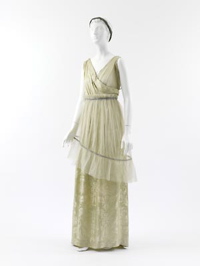 Angela Carter’s short story “The Bloody Chamber” is a Bluebeard tale in which the young narrator, a penniless pianist (“a virgin of the arpeggios”), becomes the bride of the richest man in France. He whisks her off to a remote seaside castle bristling with treasures: A Bechstein in the music room, cabinets of Limoges and Sèvres, a library lined with “calf-bound volumes, brown and olive, with gilt lettering on their spines, the octavo in brilliant scarlet morocco.” From all this we’re to conclude that this Bluebeard is a connoisseur and collector of many fine things, including wives. For these hapless young ladies, their husband’s art collection must serve as a first warning sign, including, amid the Fragonards, Watteaus and Pouissins, an ominous trio of Symbolist paintings: A Moreau entitled Sacrificial Victim, an Ensor called The Foolish Virgins, and a late Gauguin called Out of the Night We Come, Into the Night We Go, which depicts “a tranced brown girl in the deserted house.”*
Angela Carter’s short story “The Bloody Chamber” is a Bluebeard tale in which the young narrator, a penniless pianist (“a virgin of the arpeggios”), becomes the bride of the richest man in France. He whisks her off to a remote seaside castle bristling with treasures: A Bechstein in the music room, cabinets of Limoges and Sèvres, a library lined with “calf-bound volumes, brown and olive, with gilt lettering on their spines, the octavo in brilliant scarlet morocco.” From all this we’re to conclude that this Bluebeard is a connoisseur and collector of many fine things, including wives. For these hapless young ladies, their husband’s art collection must serve as a first warning sign, including, amid the Fragonards, Watteaus and Pouissins, an ominous trio of Symbolist paintings: A Moreau entitled Sacrificial Victim, an Ensor called The Foolish Virgins, and a late Gauguin called Out of the Night We Come, Into the Night We Go, which depicts “a tranced brown girl in the deserted house.”*
Rereading “The Bloody Chamber” this weekend I grew interested in the bride’s trousseau, especially a Poiret dress that she wears twice in the story — once to the opera, when she is taken to Tristan during the courtship, and a second time when she loses her virginity at the castle by the sea. The dress is described as “a sinuous shift of white muslin tied with a silk string under the breasts,” although later it’s a “chaste little Poiret shift.” So: It’s sensually provoking to wear, yet virginal to look at. Both times M. Bluebeard requests that his child-bride wear the dress with a choker of crimson rubies around her throat, an aristocratic fashion rooted in guillotine humor. (Later, he will try to lop off her head. Ladies, I implore you, inspect those gifts of jewels for all possible meaning and significance before accepting!)
Interestingly, decapitation also pops up in an anecdote connected to Poiret’s own life. As Hamish Bowles recounts in Vogue, the Parisian designer’s early clients were put off by the “brazen modernity of his designs, such as a Confucius coat innovatively cut like a kimono. ‘What a horror,’ Poiret recalled the formidable Russian Princess Bariatinsky exclaiming when he presented her with it. ‘When there are low fellows who run after our sledges and annoy us, we have their heads cut off, and we put them in sacks just like that.'”
Other gratifying Poiret links:
• A gallery of images from the Met’s 2007 “Poiret: King of Fashion” exhibit.
• A slideshow paying tribute to Poiret’s freeing influence on women’s fashion (illuminating to tie this to the dress’s stimulating qualities in the Carter story).
• A lengthy but fascinating article by Whitney Chadwick that highlights Poiret’s costume design.
• Poiret paper dolls!
* I can’t find images of these paintings online or indeed any mention of them independent of discussions of “The Bloody Chamber,” so I leave it to ALN readers to tell me if Carter made them up.
The Poiret dress shown here is a 1913 “Théâtre des Champs-Élysées” evening gown made of ivory silk damask with an overskirt of ivory silk tulle. Credit: Photograph Studio, Metropolitan Museum of Art.
Archives for January 8, 2008
TT: Almanac
“Old age is a shipwreck.”
Charles de Gaulle, The Call to Honor
